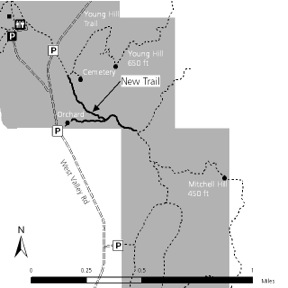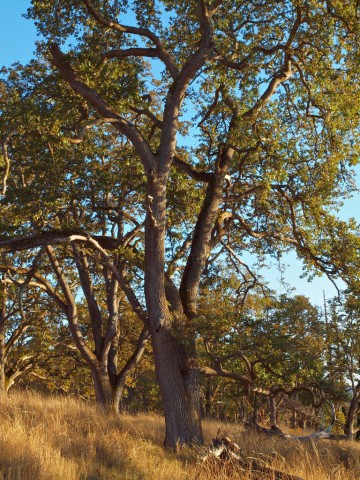New Connector Trail
Park visitors can now easily access the Mitchell Hill trail area from the Young Hill trail via a new relatively level connector which crosses the south slope of Young Hill. The trail forks to the right or south just as the main Young Hill trail switchbacks left toward the cemetery and summit of Young Hill. The intersection is marked. This enables the public to enter the more than 312 acres of woodlands and trails of Mitchell Hill, which adjoins the southeast boundary of English Camp unit. The trail connector is for hikers only. Horseback riders and bicyclists will continue to use the Horse Trail Road gate and/or other entrance points approved by the park.
“Because of limited parking at the Mitchell Hill gate on Horse Trail Road (off West Valley Road) it was essential for us to ensure access to these spectacular parklands, without crossing over the hill’s summit or walking along the roadway,” Taylor said. ‘This is especially important for seniors and those who have trouble with steep hills.”
It is now possible to traverse the open south slope, passing through healthy Garry oak woodland with views of the alpaca farm, Mitchell Bay and the Haro Strait beyond. Some walkers may want to take a spur trail down across the Military Road to the Sandwith Orchard, where the National Park Service has been restoring a historic orchard utilizing seedlings created with grafts for some of the still-living heirloom trees. The trail connector then slips through a shady Douglas fir forest and emerges at a well-marked crossroads.
The 2010 acquisition of Mitchell Hill property was the first major addition to the park since $3.5 million was allocated when President Lyndon B. Johnson signed the park’s enabling legislation into law in 1966, and ensured that Mitchell Hill, combined with the park’s present 1,752 acres, would be preserved and protected for the benefit of future generations.
The property was acquired from the Washington State Department of Natural Resources (DNR) through a $6 million Congressional appropriation included in President Barack Obama’s 2010 budget and backed by U.S. Rep. Rick Larsen and Sens. Patty Murray and Maria Cantwell. The transaction was completed in partnership with the San Juan County Land Bank, the San Juan County Council and the Conservation Fund.
The DNR managed the site as one of its “Common School Trust Lands” for the benefit of public schools. To that end the land was to be protected and conserved for sustainable forest productivity while maintaining water quality, and fish and wildlife habitat. While grazing has occurred and timber was harvested in the 1940s and again in the 1990s, much of the site is forested with trees ranging from seedlings to 120 years old, including Western red cedar, hemlock, Douglas fir and Garry oak. The area is laced with logging roads and hiking trails, many of which appear on San Juan Island Trails Committee maps.
But some of the most exciting features on Mitchell Hill are traces of the historic military road that bisects the northern edge of the property. This portion of the road was constructed by Royal Marines to travel between American and English camps during the joint military occupation of 1859-1872. The road followed the path of a sheep run cleared by Hudson’s Bay Company and Cowichan laborers. Visible along portions of the road is rip-rap — rock placed by British troops to reinforce the road — as well as wheel ruts from wagons that once rolled along the road. A few road cuts are evident on rock faces along the canopied forest paths. “The military road, in essence, captures the period before the U.S. took formal possession of San Juan Island when the boundary dispute was resolved,” said National Park historian Mike Vouri, author of three books about the joint military occupation era. “Not only did the road symbolize peacekeeping, it tied one end of island with the other,” Vouri said. “This is very much a part of the island’s heritage.” Besides its historical value, Mitchell Hill is also treasured by bicyclists, hikers and horseback riders.

